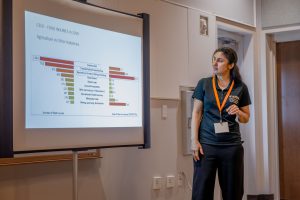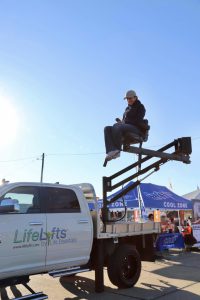It has been a hundred years or more since most Americans lived on a farm. That number dropped steadily during the 20th century until now, when it’s about two percent. Today, most people live in urban and suburban areas and have no connection to, or direct knowledge of, agriculture. And yet, of course, agriculture remains our most essential industry because it supplies the food we find in our grocery stores and restaurants.
In addition to being our most essential industry, agriculture is also one of the most dangerous. This may be surprising, but the rate of injury and death in agriculture and its allied industries of forestry and fishing is about seven times the average rate for all industries.
Why is Agriculture So Dangerous?
To answer this question, we need a specialist in agricultural safety, and that brings us to Dr. Serap Gorucu.
Dr. Gorucu is an Assistant Professor in Risk Analysis, Safety, and Health of Agricultural Systems in UF’s Department of Agricultural and Biological Engineering. Her main job is to understand the extremely diverse agricultural operations in Florida, the hazards their workers face, and propose practices or devices that can make the agricultural workplace safer.
The answer to our question is complex, but Gorucu explains that it has three main elements. First, agricultural workers face a wide variety of hazards in the workplace, including vehicles, machinery, chemicals, heat, and electricity, among others. Second, the farm or ranch is not just a workplace, it is also where many agricultural families live, and children are often engaged in agricultural work from an early age. Even when they are not working, children and teenagers can be exposed to the hazards of the agricultural workplace. You will never see a child working at a construction site, but child work is common on farms and ranches; in fact, it is often a tradition. Third, injuries and deaths that are “agriculture-related” may not be categorized as “agricultural” by agencies, and important patterns of injury and death may not be detected.

Vehicles represent a significant hazard for all three of these elements. Tractors in particular are often operated off-road and on uneven terrain. Tractor overturns are often fatal when a tractor driven along a slope rolls to the side and pins the driver to the ground or sometimes submerges the driver in a canal. Tractors are usually designed for one person – the driver – but occasionally, others are taken along – perhaps a family member or eager child – and with no provision for restraint, an extra rider can fall off the tractor and be run over. Increasingly, as the urban fringe grows out into agricultural lands, there are more conflicts between tractors and farm vehicles using public roadways and automobiles. These crashes are often disastrous for drivers and passengers.
In a recent paper, “What about the Rest of Them?”, Gorucu and her colleagues examined a range of fatal incidents that are “agriculture related” but are not within the strict definition of “agricultural” used by the federal agencies that collect and report these data. For example, in one case that Gorucu and colleagues discovered by reviewing agricultural injuries and deaths collected from media reports by AgInjuryNews.org, a 67-year-old was fatally injured when the car she was riding in rear-ended a tractor pulling farm equipment on a public roadway. This death was not classified as agricultural because the individual who died was not engaged in agricultural work. Gorucu and other agricultural safety specialists want these types of injuries and deaths to be properly collected and included in official statistics so that we can understand what is happening and where. If we don’t know there is a problem, how can we address it?

Of course, Gorucu and her many colleagues who are passionate about protecting the lives of agricultural workers and families know about the problem. The next step is making the problem visible to the rest of us, especially the agencies that report agricultural deaths and injuries. As these additional patterns of incidents show up officially, they will set into motion mechanisms for research and intervention that can prevent these incidents, and lives will be saved.
Beyond the personal impact of agricultural injury and death, we should consider their impact on entire farms. Most of Florida’s almost 48,000 farms are small operations of a few hundred acres. All farms operate on tight budgets with profits at risk from climate change and acute weather events, but for small farms, profitability is more precarious. Consider the impact on such a farm if one of the owners, workers, or children is injured or killed. Incidents like that can destroy a family’s livelihood and shut down its farm operations.
This precariousness is the situation of farmers around the world. As mentioned above, about two percent of Americans are engaged in agriculture, but worldwide, the number is estimated at around 1 billion workers – just under 30% of the world’s workforce. For all of them, agricultural safety is a critical issue, especially for the vast majority who do not have modern workplaces and have greater exposure to disease and mechanical injury.
Gorucu’s goal of uncovering sources of injuries and deaths and working to prevent them applies beyond agriculture. How many times have you seen a stack of unused shipping pallets sitting behind a business or next to a dumpster and wondered what you could make out it? Many people take this to the next step and take these pallets home where they use them as they are or take them apart and use the raw materials in projects. As Gorucu points out in a recent paper, our DIY culture and its many videos promote this kind of repurposing. However, these pallets result in thousands of visits to emergency rooms every year, and the numbers do not include those who do visit the emergency room or who seek medical help at other locations. 
Recently, Gorucu has been using video technologies and automated ergonomic assessment to examine potential hazards for workers in agriculture-related industries. Work in these industries often involves repetitive motions that can lead to serious disability. Gorucu and her assistant Julian Williamson examined repetitive motion injuries in the Florida greenhouse and nursery industry. Florida is the second largest producer of landscape and ornamental plants in the U.S. The industry brings billions of dollars into the state and employs thousands of workers. Statistics show that this industry has the highest rate of worker compensation claims compared to other agricultural operations.
Videos of workers engaged in repetitive operations were analyzed using an AI-based software that automatically diagrams bodies in motion to help detect sources of repetitive motion injury. They examined the video segments frame by frame, which allowed Gorucu and Williamson to compare the motions of different workers for the same task, noting that the equipment, which was not adjustable, presented different risks for workers with different heights. This detailed comparison also gave insights into the optimal postures for the observed tasks and how the workplace could be organized to reduce stress on a worker’s joints. Their recommendations included varying work tasks during the day, making the equipment adjustable for worker height, and training employees about the relationship between posture and joint stress.
This type of analysis can lead to actions that prevent many worker injuries in the greenhouse and nursery industry. Gorucu looks forward to extending this work to other agricultural operations to provide detailed roadmaps for better worker protection and make agriculture safer.
That’s UF ABE: Big Questions, Global Reach!
This article was written by: Charles Brown
 0
0


